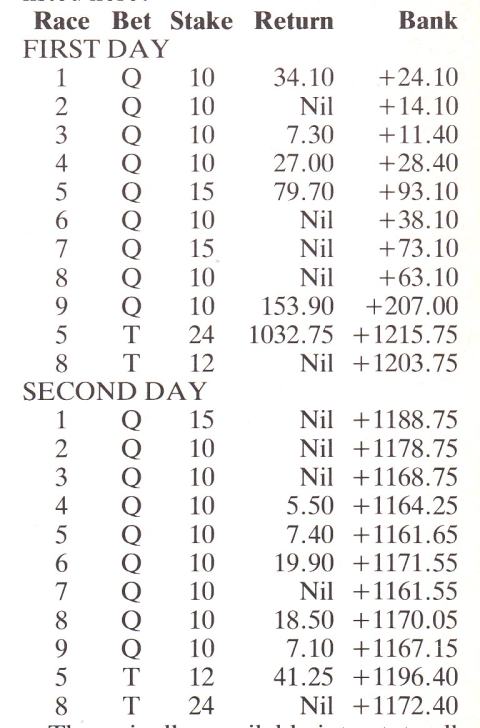You know, there are plans and plans, and most of them lose. I could give you hundreds of examples of losing plans which when their owners first devised them were apparent world-beaters.
Well, on February 10 the NSW TAB introduced extended quinella betting. The Victorian TAB is way ahead here, and ACT TAB has had it for ages. Still it represents progress for the punter.
I do wonder what will be left to attract the punter to the track when the trifecta is extended to most - if not all - races. A super-fecta won't do it, unless the punter is in cuckoo land and believes he really has a chance of putting the first six in their correct order.
Personally, I can recall doing that once in my life: I had a standout trifecta with five horses to place and they finished 2, 3, 4, 5, 6 behind my selection to win.
Rack to business. I came up with an idea, based on the fact that in most states you can now bet on every race's quinella. This is at least true of your home state's races. I wondered about the reliability of the markets. Not the accuracy in terms of odds, but rather the placement of the horses in the market. I have maintained for a long time that the market is given to making wild assumptions about favourite prices (it places so many even money pops at 5-2, even 3-1). But it gets the order reasonably correct, and often when it doesn't it gets the finishing positions pretty well sorted out.
So I thought up a plan to try on the NSW TAB for the quinellas and also for trifectas when they were available. At time of writing there are still only two trifectas per meeting, but that will have changed by the time you are reading this. I believe that there will be four.
I decided to take the first five in the first market for a dollar each, and to add my favourite rider when he was riding a horse outside those five.
So here are the rules:
- Take the first five in the market after scratchings.
- If Jim Cassidy is riding a horse not in those five, add it to make a sixth selection.
This means you are up for either $10 or $15 per race. If you like you could do it in 50 cent units and it would then cost $5 or $7.50 per race.
For the trifecta:
- Take the first horse listed with the next three in a standout ($6).
- Take the second horse listed with the first, third and fourth horses in a standout ($6).
- If Cassidy is riding, take his mount with the first three in the market as a standout ($6).
- Note that Cassidy's mount might be one of the top three; in this case just go to the next horse listed.
- If Cassidy is riding, take a box trifecta of the first and second favourite and his mount.
- Note again the same proviso as rule three has: if his is one of the top two, you would take it with the next two in order.
Example: Cassidy is riding the second favourite. Take it with the first and third favourite. The results for the first two days are listed here:

The quinellas available interstate all won, but the trifectas lost. It is interesting to note that Cassidy was placed 3rd in the eighth race on the second day, but while the first listed won, the 2nd placegetter was listed fifth: so we had the quinella but missed the trifecta which paid a bit over $200.
The previous day's Race 8 trifecta was won by a 66-1 pop and there was no way we could have found it.
The quinellas and trifectas both won on this very short test run, although it should be noted that the second day still registered a loss of about $31 and this may prove to be the norm rather than the first day, which might be the anomaly. There is no way we can know this, because it is a new ball game, but I thought the exercise was worth doing with you. If you decided to only do the trifectas you could be a long way in front, but the question is raised: will it happen again? I don't see why not, since the idea is soundly based, and costs a maximum of $48 per day.
A bank of, say, $500 would give you at least 10 city meetings at two trifectas per meeting, or five at four per meeting. The thing is, can we expect to hit a trifecta in 209 Yes, I believe we would. Would it cover outlay? Now that's a good question. How many of you are out there? If 1,000 readers all tried, the odds would go down on the trifecta. It's something we just can't know.
For all that, it's an interesting Plan of the Month, and one you might like to do some work on. Keep at it!
By The Optimist
PRACTICAL PUNTING - APRIL 1986